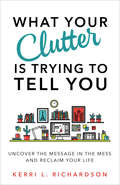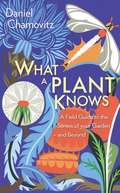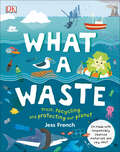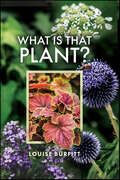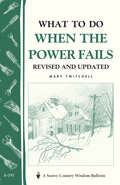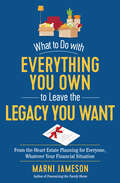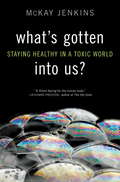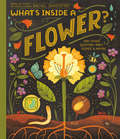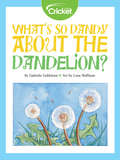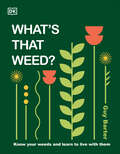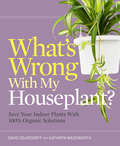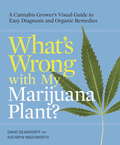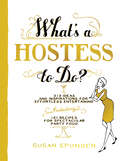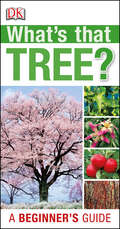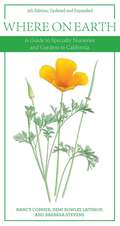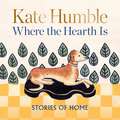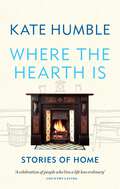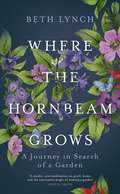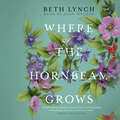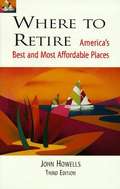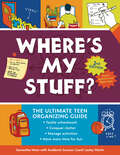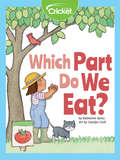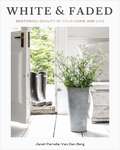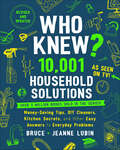- Table View
- List View
What Would the Buddha Recycle?: The Zen of Green Living
by Rosemary RobertsIf the Buddha were alive today, he'd be the living embodiment of green living. He'd be collecting cans on the freeway, riding his bike to work, and replacing all his light bulbs one little satori at a time. In this book you can channel His Holiness, reduce your footprint, and experience little Aha! moments when you: - Eat mindfully and lose the meat - Make a Zen garden that nourishes the earth - Choose sustainable clothing - Meditate while walking instead of driving - Let go of attachment to things by giving away belongings Living green is living Zen. Now you can take right action and walk a green talk, starting today -- just think how proud the Buddha would be!
What Your Clutter Is Trying to Tell You
by Kerri L. RichardsonWith practical and warm advice, lifestyle designer and coach Kerri Richardson guides you to accept your clutter as a natural manifestation of your mind, body, and spirit looking out for yourself. It is your soul calling out for you to invest in self-care and to face the fears holding you back from being your best self. Richardson dives into the most common categories of physical clutter and provides efficient and effective steps for clearing the space for your physical, mental, and spiritual well-being to flourish. But more than house and home, Richardson encourages you to clear out the clutter of relationships and habits that have been occupying your time and energy for too long.
What a Plant Knows: A Field Guide to the Senses of Your Garden - and Beyond
by Daniel ChamovitzHow does a Venus flytrap know when to snap shut? Can an orchid get jet lag? Does a tomato plant feel pain when you pluck a fruit from its vines? And does your favourite fern care whether you play Bach or the Beatles? Combining cutting-edge research with lively storytelling, biologist Daniel Chamovitz explores how plants experience our shared Earth - through sight, smell, touch, hearing, memory, and even awareness. Whether you are a green thumb, a science buff, a vegetarian, or simply a nature lover, this rare inside look at the life of plants will surprise and delight.
What a Waste: Trash, Recycling, and Protecting our Planet (Protect the Planet)
by Jess FrenchIn this informative book on recycling for children, you will find everything you need to know about our environment. The good, the bad and the incredibly innovative. From pollution and litter to renewable energy and plastic recycling.This educational book will teach young budding ecologists about how our actions affect planet Earth and the big impact we can make by the little things we do.Did you know that every single plastic toothbrush ever made still exists? Or that there is a floating mass of trash larger than the USA drifting around the Pacific Ocean?It is not all bad news though. While this is a knowledge book that explains where we are going wrong, What a Waste also shows what we are getting right! Discover plans to save our seas. How countries are implementing green projects worldwide, and how to turn waste into something useful. The tiniest everyday changes can make all the difference to ensure our beautiful planet stays lush and teeming with life. It is a lively kid&’s educational book with fabulous illustrations and fun facts about the world broken into easy to digest bite-sized bits. Each page can be looked at in short bursts or longer reads for more detail, making it a great children&’s book for a range of age groups.Get Involved - Make A Difference!Almost everything we do creates waste, from litter and leftovers to factory gases and old gadgets. Find out where it goes, how it affects our planet and what we can do to reduce the problem. From how to make your home more energy and water efficient, to which items can be recycled and tips for grocery shopping, this book is packed full of ideas on how you can get involved to make our planet a better place to live.This environment book for children has a wealth of ideas for becoming a planet-defending hero:- Discover shocking facts about the waste we produce and where it goes- Learn where about our Earth&’s limited resources and how to take some pressure off- Your trash is another man&’s treasure- Small changes to take your home from wasteful to super resource efficient- Dive into saving our oceans and super recycling- And much, much moreWhat a Waste is one of several nature books for kids written by Jess French, a passionate conservationist and veterinarian committed to protecting the beautiful world we live in.
What is that Plant?
by Louise BurfittSpring is the most captivating season of the year for both novice and veteran gardeners as green shoots emerge from bare earth, announcing the promise of beautiful blooms to come. But have you ever found yourself crouched beside a flower bed, puzzling over which plants exactly are pushing their way through the soil? Difficult, but by no means impossible – and this is where this picture-led book, jam-packed with useful information, compelling facts and identification tips for beginners, is at hand. Cataloguing 150 common garden plants found in Britain and Europe, the book covers perennials, flowers, shrubs, weeds and wildflowers as well as a unique section on self-seeding plants, which merrily spread about our gardens and can prove difficult to identify. As well as satisfying your curiosity, identifying the plants in your outdoor space will help you get the most out of your plot. Without knowing which flowers, herbs, shrubs or weeds you are working with, it is impossible to give your garden or allotment the care it needs to thrive. And even those without the luxury of their own outdoor space will find interesting insights on plant names and origins alongside intriguing historical tidbits in this engaging field guide, from the connection between daffodils and dementia in Wales to the controversial history of the hawthorn tree. In this comprehensive directory, you’ll find garden plants organized according to type with hands-on advice for identifying the mystery interlopers in your borders, and information about their height, spread, flowering period and toxicity. Discover a wide array of British garden plants, with practical tips for their care and uses.
What to Do When the Power Fails: Storey's Country Wisdom Bulletin A-191 (Storey Country Wisdom Bulletin Ser.)
by Mary TwitchellSince 1973, Storey's Country Wisdom Bulletins have offered practical, hands-on instructions designed to help readers master dozens of country living skills quickly and easily. There are now more than 170 titles in this series, and their remarkable popularity reflects the common desire of country and city dwellers alike to cultivate personal independence in everyday life.
What to Do with Everything You Own to Leave the Legacy You Want: From-the-heart Estate Planning For Everyone, Whatever Your Financial Situation
by Marni JamesonYou can’t take it with you, but you can ensure that what you leave behind has value and meaning. Whether you want the fruits of your life’s work to benefit your family, the environment, science, human rights, the arts, your church, or another cause dear to you, one thing is certain: It won’t happen unless you plan. What to Do with Everything You Own to Leave the Legacy You Want is a step-by-step, DIY guide to turning your money and “stuff” into something meaningful that will outlast you—whether you are in the prime of life or your later years, single or partnered, have kids or not, are well-off or of modest means. With her trademark practical wisdom, downsizing expert Marni Jameson offers plenty of comfort (and even some laughs) as she guides you through the following: Identifying whom you want to benefit from your legacy Navigating wills, trusts, and other paths to your goals Heading off potential family conflicts Making the best plan for your material assets This book will encourage and inspire you through every step of your final downsizing project, helping you make a positive impact on the people and causes closest to your heart.
What's Gotten into Us? Staying Healthy in a Toxic World
by Mckay JenkinsDo you know what chemicals are in your shampoo? How about your cosmetics? Do you know what's in the plastic water bottles you drink from, or the weed killer in your garage, or your children's pajamas? If you're like most of us, the answer is probably no. But you also probably figured that most of these products were safe, and that someone--the manufacturers, the government--was looking out for you. The truth might surprise you.After experiencing a health scare of his own, journalist McKay Jenkins set out to discover the truth about toxic chemicals, our alarming levels of exposure, and our government's utter failure to regulate them effectively. The result of his two-year journey, What's Gotten into Us?, is a deep, remarkable, and empowering investigation into the threats--biological and environmental--that chemicals now present in our daily lives. It reveals how dangerous, and how common, toxins are in the most ordinary things, and in the most familiar of places: * Our water: Thanks to suburban sprawl and agricultural runoff, 97 percent of our nation's rivers and streams are now contaminated with everything from herbicides to pharmaceutical drugs. * Our bodies: High levels of hormone-disrupting chemicals from cosmetics, flame-retardants from clothing and furniture, even long-banned substances like DDT and lead, are consistently showing up in human blood samples. * Our homes: Many toxins lurk beneath our sinks and in our basements, of course, but did you know that they're also found in wall-to-wall carpeting, plywood, and fabric softeners? * Our yards: Pesticides, fungicides, even common fertilizers--there are enormous, unseen costs to our national obsession with green, weed-free lawns. What's Gotten Into Us? is much more than a wake-up call. It offers numerous practical ways for us to regain some control over our lives, to make our own personal worlds a little less toxic. Inside, you'll find ideas to help you make informed decisions about the products you buy, and to disentangle yourself from unhealthy products you don't need--so that you and your family can start living healthier lives now, and in the years to come. Because, as this book shows, what you don't know can hurt you.From the Hardcover edition.
What's Inside A Flower?: And Other Questions About Science & Nature (What's Inside)
by Rachel IgnotofskyFrom the creator of the New York Times bestseller Women in Science, comes a new nonfiction picture book series ready to grow young scientists by nurturing their curiosity about the natural world--starting with what's inside a flower.Budding backyard scientists can start exploring their world with this stunning introduction to these flowery show-stoppers--from seeds to roots to blooms. Learning how flowers grow gives kids beautiful building blocks of science and inquiry.In the launch of a new nonfiction picture book series, Rachel Ignotofsky's distinctive art style and engaging, informative text clearly answers any questions a child (or adult) could have about flowers.
What's So Dandy About the Dandelion?
by Gabriele GoldstoneThe name dandelion comes from the French for "tooth of the lion." But are these flowers actually dangerous?
What's That Weed?: Know Your Weeds and Learn to Live with Them
by DKLearn all about common weeds and how they affect your garden to make informed decisions about the plants you want in your patch - and how to manage those that you don't.Figuring out which weed is which can be tricky for new and seasoned gardeners alike. In this book, garden expert Guy Barter lifts the lid on how weeds grow and in what conditions. Discover each weed's benefit to wildlife, biodiversity, and its role in the environment - plus whether it has ornamental, herbal, or edible properties that you might want to make the most of.This identification guide covers 40 weeds commonly found in gardens in Europe and North America. Alongside well-known weeds such as nettles, dock, dandelions, and bindweed, you'll find hawksbeard, pearlwort, ivy-leaved speedwell, and pennycress.In this book, you will find: -Detailed photographs and diagrams of each element of the plant, from roots to leaves-Specific tools to help you recognize weeds throughout their entire life cycles, from starting out as seedlings before growing into mature flowers.-The best way to manage each weed and curate the perfect plants for your patch.-Each weed's place within the ecosystem is listed, along with benefits, such as use as an ornamental, herbal, or edible plant-Every element of the 40 weeds along each stage of their life cycle, enabling clear identification for gardeners.With this guide, you can identify plants and understand more about weeds and roots and their benefits.The perfect title for seasoned gardeners who are looking to identify, manage, and control the weeds in their gardens or new gardeners who are keen to learn about and identify the existing plants in their gardens.
What's Wrong With My Houseplant?: Save Your Indoor Plants With 100% Organic Solutions (What’s Wrong Series)
by David Deardorff Kathryn WadsworthThis book will turn even the brownest thumbs green! Houseplants add style, clean the air, and bring nature indoors. But they are often plagued with problems—aphids, mealybugs, mites, and thrips to name just a few. What’s Wrong With My Houseplant? shows you how to keep indoor plants healthy by first teaching you how to identify the problem and solve it with a safe, natural solution. This hardworking guide includes plant profiles for 148 plants organized by type with visual keys to the most of common problems, and the related organic solutions that will lead to a healthy plant.
What's Wrong with My Marijuana Plant?: A Cannabis Grower's Visual Guide to Easy Diagnosis and Organic Remedies
by David Deardorff Kathryn WadsworthA simple step-by-step system for identifying, repairing, and preventing problems with marijuana plants.What's Wrong with My Marijuana Plant? is the first problem-solving book for marijuana growers with an effective and easy-to-use visual diagnostic system pioneered by Deardorff and Wadsworth for identifying pest, disease, and environmental problems by symptom. What are those rusty spots on your leaves? What bug is eating your buds? Why are your sativa sprouts covered in fuzz? Find out fast AND learn how to fix it! This book contains all-organic solutions (vitally important to protect your health, the health of your plants, and the environment) plus best growing practices to avoid problems before they start. Written in easily understandable, non-technical language and heavily illustrated with precise photography to allow rapid and accurate diagnosis, this is an essential resource for beginning and experienced growers alike.
What's a Hostess to Do?: 313 Ideas And Inspirations For Effortless Entertaining
by Susan SpungenIn What's a Hostess to Do?, entertaining expert Susan Spungen explains everything you need to know to host a party effortlessly and with elegance. Susan shows the hostess how to make it look easy--whether the occasion is an informal brunch, a sit-down dinner, a buffet for a crowd, or an impromptu birthday celebration. It's all arranged in 313 easy-to-digest entries that take readers through every aspect of entertaining. The tips are time-saving ("Ten Great Assembled Dessets"), money-saving ("In Praise of Cheap Wine"), energy-saving ("Ten Jobs to Delegate"), and face-saving ("How to Handle Uninvited Guests"), plus there are 121 recipes to make entertaining easier than ever berfore. With helpful illustrations and full-color photographs, What's a Hostess to Do? is a stylish and instructive guide filled with expert advice from a party-throwing pro.
What's that Tree?: A Beginner's Guide (DK What's That?)
by DKLearn more about the beautiful trees around you with this identification guide, perfect for beginners, featuring over 150 common tree species. If you want to know the difference between a Serbian spruce and a silver birch or how different trees change through the seasons then What&’s that Tree? is the ideal guide for you. Species overviews show you what to look for where and related trees are shown side by side for quick comparison and identification.Clear photography of leaves will help you to directly compare the tree you&’re looking at with those in the guide and will assist you with specific features of the leaf to help identify the tree. This quick-reference guide also includes information on bark, flowers, and seeds. The perfect pocket guide for beginners but also a handy reference for the more seasoned naturalist, What&’s that Tree? will help you to become an expert tree-spotter in no time.
Where on Earth: A Guide to Specialty Nurseries and Gardens in California
by Nancy Conner Barbara Stevens Demi LathropEver since its initial publication in 1993, this guide to California's specialty plant nurseries has been an invaluable tool for gardeners and landscapers, and it is now available in an expanded and completely revised edition. Organized by geographic region, each listing provides essential information, including address, contact information, hours, plant offerings, and a detailed description of the facility and its owners. In addition to featuring specialty nurseries, Where on Earth catalogs notable garden centers, plant societies, education programs, and horticultural attractions throughout the state, as well as mail-order sources for bulbs, seeds, and rhizomes. The coauthors also include twelve essays, one for each region, that address that area's special features and gardening concerns. Whether you're searching for antique roses on the foggy North Coast, water-wise succulents and native shrubs around Los Angeles, or a palm doctor for your sickly cycads in the Central Valley, this book gives current, detailed advice for plant lovers to see, shop, and savor.
Where the Hearth Is: Stories of home (Kate Humble)
by Kate HumbleKate Humble has a knack for sharing her own journey towards a more pleasing and purposeful life in a way that inspires readers, enables them to reassess their own lives and helps them achieve their personal goals. Having encouraged readers to reconnect with nature in Thinking on My Feet and simplify their lifestyles in A Year of Living Simply, she turns now to reimagining the ideal home - examining her own experiences and expectations, considering all the elements necessary to futureproof her home life, taking advice from others living uniquely, extraordinarily, happily, and gaining insights from some unexpected quarters - including the animal kingdom.As our time spent in office buildings and other traditional workplaces shrinks forevermore, feeling happy, healthy, productive and content in our homes (be they castles or caravans, flat-shares or farms, fixed or temporary, inner city/out of town/beyond) is more important to get right than ever before. Where the Hearth Is will resonate with all those seeking to make the most of their lives during the many hours we all spend at home - whether it's a case of tiny adjustments while staying put, moving out, living differently or dreaming of building something new.
Where the Hearth Is: Stories of home (Kate Humble)
by Kate Humble'A celebration of people who live a life less ordinary' - Country Living'A discovery of what makes us feel we belong' - Yours Magazine'From crofts to castles... Where the Hearth Is explores what makes a home. It's hard to define, but drawing on the stories of those she meets, everyone knows when they have found it.' - The ScotsmanWhat is it about a place that makes us feel truly home? Kate Humble has a knack for sharing her own journey towards a more pleasing and purposeful life in a way that inspires readers, enables them to reassess their own lives and helps them achieve their personal goals. Having encouraged readers to reconnect with nature in Thinking on My Feet and simplify their lifestyles in A Year of Living Simply, she turns now to reimagining whatever we consider 'home' - examining her own experiences and expectations, ideals and memories, and considering the views of others living uniquely, extraordinarily, happily. And she's gaining insights from some unexpected quarters - including the animal kingdom.As our time spent in office buildings and other traditional workplaces shrinks forevermore, feeling happy, healthy, productive and content in our homes (be they castles or caravans, flat-shares or farms, fixed or temporary, inner city/out of town/beyond) is more important to get right than ever before. Where the Hearth Is will resonate with all those seeking to make the most of their lives during the many hours we all spend at home - whether it's a case of tiny adjustments while staying put, moving out, living differently or dreaming of building something new.
Where the Hornbeam Grows: A Journey in Search of a Garden
by Beth Lynch'Beth Lynch's subtle and moving book is about the heart-work of finding and making a place for oneself in the world; the effort of putting down roots, the pain of tearing them up again, and how one grows to know another person or another landscape. Horticulture and human feelings twine together here - and what flourishes in the several gardens of this book is, in the end, hope' ROBERT MACFARLANE'I loved Beth Lynch's tender, wise meditation on grief, home, and the restorative magic of making a garden' OLIVIA LAINGOut of place and lonely after a relocation to Switzerland, Beth Lynch realises that she needs to get her hands dirty if she is to put down roots. And so she sets about making herself at home in the way she knows best - by tending a garden, growing things. The search for a garden takes her across the country, through meadows and on mountain paths where familiar garden plants run wild, to the rugged hills of the Swiss Jura where she begins to plant her paradise. WHERE THE HORNBEAM GROWS is a memoir about carrying a garden inwardly through loss, dislocation and relocation, about finding a sense of wellbeing in a green place of one's own, and about the limits of paradise in a peopled world. It is a powerful exploration of how, in nurturing a corner of the natural world, we ourselves are nurtured.
Where the Hornbeam Grows: A Journey in Search of a Garden
by Beth Lynch'Beth Lynch's subtle and moving book is about the heart-work of finding and making a place for oneself in the world; the effort of putting down roots, the pain of tearing them up again, and how one grows to know another person or another landscape. Horticulture and human feelings twine together here - and what flourishes in the several gardens of this book is, in the end, hope' ROBERT MACFARLANE'I loved Beth Lynch's tender, wise meditation on grief, home, and the restorative magic of making a garden' OLIVIA LAINGOut of place and lonely after a relocation to Switzerland, Beth Lynch realises that she needs to get her hands dirty if she is to put down roots. And so she sets about making herself at home in the way she knows best - by tending a garden, growing things. The search for a garden takes her across the country, through meadows and on mountain paths where familiar garden plants run wild, to the rugged hills of the Swiss Jura where she begins to plant her paradise. WHERE THE HORNBEAM GROWS is a memoir about carrying a garden inwardly through loss, dislocation and relocation, about finding a sense of wellbeing in a green place of one's own, and about the limits of paradise in a peopled world. It is a powerful exploration of how, in nurturing a corner of the natural world, we ourselves are nurtured.
Where to Retire: America's Best and Most Affordable Places
by John HowellsIn this well-researched guide, the author gives the best advice not only on where to relocate in your retirement years, but why you should pick up and move just as life is settling down. The books presents clear snapshots of life in hundreds of the most affordable, comfortable, and stimulating places to retire in the US.
Where's My Stuff? 2nd Edition: The Ultimate Teen Organizing Guide
by Samantha Moss Lesley MartinA comprehensive guide for young adults on how to organize schoolwork, lockers, bedrooms, and even schedules. Take a quiz to identify your organizing style and get great advice about making decisions, purging closets, and creating the perfect space to relax, work, and store belongings. With fun and useful illustrations, easy-to-follow charts, and ample doses of humor, Where's My Stuff? is an incredible asset for anyone who wants to get it together and keep it together, for good. Newly updated for readers living in a digital world, this 2nd edition includes tips on managing online files and backups, digital planners, and more. Written in collaboration with professional teen organizer Lesley Martin.
Which Part Do We Eat?
by Katherine Ayres Carolyn CrollHave you ever walked through a garden and wondered which part of a fruit or vegetable you’re supposed to eat? It could be the pod, the leaves, the seeds, the root, or even the flower! Follow along with this poem to learn about fresh, tasty veggies!
White and Faded: Restoring Beauty in Your Home and Life (Perfect for People Who Love Interior Design, Decorating, and Creating Beautiful, Healing Spaces at Home)
by Janet Parrella-Van Den BergFind new value, purpose, and joy as you restore and uncover beauty in your home and (most importantly) in your life.The only thing more beautiful than home transformation is personal transformation. In White & Faded Janet Parrella-Van Den Berg takes you on a hope-filled journey to discover the hidden beauty in your own home and heart.We've all experienced it at some time, like an old piece of furniture we have felt unloved, discarded, neglected, or valueless. We've struggled with our own self-worth in moments of darkness when we feel like nobody cares about us and nobody wants us. But in these moments of despair sometimes the beginning of a journey toward hope can come from unlikely sources…like uncovering the charm and elegance of an antique chair or dresser that has had its true worth obscured by years of disuse and realizing that like that antique we still have beauty and life within ourselves. In White & Faded, Janet Parrella-Van Den Berg takes you on a stunning photographic tour through her restored English homes as she invites you into her personal journey of restoring her own sense of value and purpose—and reveals how you can do the same. So, what is White & Faded? As Janet explains, she loves white things as a culmination of all colors and a representation of new mercies. And she loves faded things, such as cast-aside furniture, as a reminder that even what is painful, or imperfect can be repurposed to reveal hidden beauty.Throughout this gorgeous and inspiring book, Janet gives you insights into both the literal and metaphorical aspects of white and faded as she draws on her decades of experience to offer you:Full-color photography of restored English country homes, including a 1767 Georgian rectory in Kent and a home originally built in 1500Practical restoration tips—from large-scale homes to smaller antiquesFresh decorative ideas you can adapt to your own style, home, and season of lifeFun inspiration—from antique to modern—ideal for fans of HGTV and Magnolia NetworkInspiration to incorporate a touch of seasonal charm throughout the yearHow to make white work with kids and petsA window into her own remarkable story of trauma, love, and rediscovered identity White & Faded will inspire you as you begin to create a place in your life where you feel loved, find healing, and discover new treasures. You deserve to feel loved, begin the journey today to restore your home and your heart.
Who Knew? 10,001 Household Solutions: Money-Saving Tips, DIY Cleaners, Kitchen Secrets, and Other Easy Answers to Everyday Problems
by Bruce Lubin Jeanne LubinA big new book on household solutions from the 5-million-copy-selling Who Knew? brand!Whether you’re cleaning house, cooking a meal, improving your appearance, or fighting a cold, this indispensable guide will help you with natural and simple solutions to your daily tasks requiring only basic—and inexpensive—items with multiple uses that you should always keep on hand in your home.Vinegar, baking soda, lemons, duct tape, and beer are just a few of the all-purpose tools you need to eliminate odors, keep your food fresher longer, get rid of pests, increase storage space, de-stress, give yourself a spa treatment, and so much more. With easy-to-follow instructions, you’ll discover clever and creative ways to give your home—and yourself—a makeover while saving time and money.

